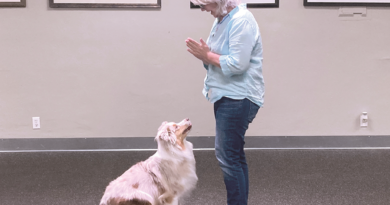Anxiety Medication for Dogs | What Can I Give My Dog for Anxiety
Anxiety in dogs has become an increasing concern over the past several years, with more and more dog owners looking to veterinary professionals for help. Why is this?
There may be a component of the increasingly stressful lives we humans lead during these challenging times, where there is never enough time in the day for all we need to do. This leaves less time for quality dog time, attention, exercise, and training.
The trend of no-kill shelters, rescue, and adoption of abandoned and homeless dogs likely plays a role as well. Unfortunately, many of these dogs will have missed out on the important golden period for socialization that begins at birth and extends all through puppyhood. Add to that the stress they endure (uncertainty, transport, shelter housing, changing handlers, multiple foster homes, etc.) before finding their forever homes, and it’s no wonder they may be starting on shaky ground.
For whatever reason it is happening, it is happening. And it’s heartbreaking. Anxious dogs are not comfortable. They can’t relax. At times, they are downright panicky. They can be destructive, which puts a strain on your relationships, canine and human. All you want to do, as the person who loves and cares for them, is help them.
Fortunately, there are many ways to help, including anti-anxiety medications. We will discuss these meds, but it is important to recognize that medication alone will never be the magic bullet, miraculously eliminating your dog’s angst and associated behavior issues. Never. Anti-anxiety meds are meant to be used to enhance the management and treatment of anxiety-associated behavior issues, the mainstay of which is behavioral modification and desensitization to triggers.
FIRST: THE INITIAL VETERINARY EXAM
The first thing you’re going to do is see your veterinarian for an exam. Some anxious behaviors turn out to be secondary to pain or illness. Correcting these underlying issues may resolve the whole problem of anxiety in your dog.
Once underlying physical conditions have been ruled out or corrected, your veterinarian will suggest a behavior-modification plan, which may include exercises to do at home, anti-anxiety medications, and/or referral to a veterinary behavior specialist, depending on the complexity of the case.
SHORT- AND LONG-TERM ANXIETY MEDICATIONS FOR DOGS
Anti-anxiety medications used in practice fall into two main groups: fast-acting, short-duration meds for as-needed, situational use; and longer-acting meds for long-term daily use.
Because the longer-acting meds take several weeks to reach peak effect, they are frequently used in combination with shorter-acting meds for the first four to eight weeks of therapy.
The shorter-acting drugs are also used intermittently as needed while on maintenance longer-acting meds, for circumstances that occasionally escalate the fear, anxiety, or phobia, i.e., “panic attacks.”
The short-acting anti-anxiety drugs will always work best when given before the fear or anxiety is triggered. If the dog is already ramped up, you’re way less likely to achieve the desired effect. So give the medication an hour or so before the fireworks or thunderstorm, getting in the car, grooming or veterinary visits, etc.
It’s always best to do a trial run with the short-term drugs when the dog is relaxed and not in the presence of the anxiety trigger. This is the best way to assess the efficacy and duration of the prescribed dose for your dog, both of which have high individual variability. This trial also screens for a weird, paradoxical reaction that occasionally occurs called a “reverse response,” where the dog actually displays increased agitation and excitation after administration of an anti-anxiety med.
Any anti-anxiety medication can result in disinhibition of aggressive behavior, so be aware, and be particularly cautious around aggressive dogs when first trying these medications.
The longer-acting drugs, which are used daily for extended periods, should always be gradually tapered, never abruptly discontinued, to avoid withdrawal symptoms such as agitation, restlessness, and irritability.
INDICATIONS FOR BEHAVIOR-ALTERING MEDICATIONS
The most common behavior issues requiring treatment include:
- Separation anxiety
- Noise phobias
- Fear aggression
- Compulsive behaviors (e.g., acral lick dermatitis/granuloma, tail-chasing)
- Fearful events (e.g., veterinary visits, grooming appointments, nail trims)
- Anxiety when being boarded or during travel.
The tables below describes the most commonly prescribed long-acting medications for anxiety in dogs; and the most commonly prescribed short-acting anxiolytic (anti-anxiety) medications. There are other medications your veterinarian may suggest, depending on your dog’s individual case and response or lack of response to therapy.
Anti-anxiety medications for dogs can be used in combination, again depending on your dog’s individual needs.
OTHER OPTIONS FOR DOGS WITH ANXIETY
There are other products available to help reduce anxiety in dogs including Adaptil (DAP, a calming pheromone), Purina Calm (a calming probiotic), Zylkene (a calming milk protein), melatonin (a calming hormone), prescription calming diets (Hill’s, Royal Canin), and herbal remedies. If your dog suffers from anxiety, you are likely eager to try anything and everything that might help.
Just remember, however, there is no magic bullet (prescription medication or over-the-counter supplement) to miraculously “fix” the problem. Behavior modification and desensitization exercises, with guidance from your veterinarian or a board-certified veterinary behavior specialist, will always be the foundation for successful treatment of anxiety and anxiety-associated behaviors in dogs.
Long-acting medication for dog anxiety
| NAME OF DRUG | FLUOXETINE (Prozac by Eli Lilly, Reconcile by Pegasus Laboratories, generics) | CLOMIPRAMINE (Clomicalm by Elanco, generics) |
|---|---|---|
| DRUG CLASS | Selective serotonin reuptake inhibitor (SSRI) | Tricyclic antidepressant (TCA) |
| EFFECTS | Anxiolytic | Anxiolytic |
| USED FOR | Separation anxiety (labeled use); aggression, compulsive disorders (off-label uses) | Separation anxiety (labeled use); compulsive disorders, noise phobias (off-label uses) |
| TIME TO FULL EFFECT | 4 to 8 weeks | 3 to 6 weeks |
| ADVERSE EFFECTS | GI upset, may lower seizure threshold, increased bleeding risk | Short-term sedation, mild gastrointestinal upset, increased or decreased appetite |
| CONTRAINDICATIONS | Seizure disorders | Thyroid disease/medication, seizure disorders, concurrent monoamine oxidase inhibitors (MAOIs), prostatic disease, glaucoma |
| USE WITH CAUTION | Bleeding disorders, diabetes, kidney disease, concurrent serotonergic agents | Cardiovascular disease, pancreatitis, dry-eye syndrome, concurrent serotonergic agents |
Short-acting medication for dog anxiety
| NAME OF DRUG | ALPRAZOLAM (Xanax by Pfizer, generics) | TRAZODONE (generics) | GABAPENTIN (generics) | DEXMEDITOMIDINE OROMUCOSAL GEL (Sileo by Zoetis) |
|---|---|---|---|---|
| DRUG CLASS | Benzodiazepine | Serotonin modulator (antagonizes and inhibits reuptake) | Anticonvulsant, analgesic | Alpha-2 adrenergic agonist |
| EFFECTS | Anxiolytic, sedative | Anxiolytic, sedative, antihistamine | Sedation, pain relief | Sedation |
| USED FOR | No labeled use in dogs. Off-label uses: Fearful events, noise phobias, adjunct as needed with SSRI or TCA for separation anxiety (e.g., departures) and/or general anxiety (e.g., situational triggers) | No labeled use in dogs. Off-label uses: Fearful events, noise phobia, travel or boarding anxiety, pre-operative sedation, post-operative confinement. Adjunct as needed with SSRI, TCA, or benzodiazepine for anxiety | No labeled use in dogs. Off-label uses: Adjunct as needed with SSRI/TCA/trazodone for anxiety and fearful events; sedation; anticonvulsant; analgesic | Noise phobia (labeled use). Off-label uses: Travel anxiety, fearful events |
| TIME TO FULL EFFECT | 20-40 minutes | 1-2 hours | 1-2 hours for single dose; 1-2 days to reach steady state when used chronically | 30-60 minutes |
| DURATION | 2-12 hours (generally 2-4 hours) | 2-12 hours (generally 4-8 hours) | Generally 4-6 hours for single dose | 2-3 hours |
| ADMINISTRATION FREQUENCY | Every 6-12 hours as needed | Every 8 hours as needed | Every 8-12 hours | Every 2 hours as needed for up to 5 treatments per event |
| ADVERSE EFFECTS | Sedation, incoordination | Sedation, mild GI upset, increased bleeding risk, increased appetite | Sedation, hind-limb weakness | Lethargy, prolonged sedation, GI upset, incoordination, paradoxical excitation, shallow breathing, low heart rate, arrhythmias, low blood pressure, pale gums |
| CONTRAINDICATIONS | Liver disease, glaucoma, concurrent CYP3A inhibitors (e.g., ketoconazole) | Concurrent monoamine oxidase inhibitors (MAOIs) | None | Cardiac/respiratory/kidney/liver disorders, severe debilitation, geriatric frailty |
| USE WITH CAUTION WITH DOGS WHO HAVE | Kidney disease | Cardiac, liver, and/or kidney disease; anticonvulsants, concurrent serotonergic agents | Kidney and liver disease | Ideally only used in robust, clinically healthy individuals |
| ADDITIONAL NOTES | Federally controlled substance. May cause physical dependence and withdrawal symptoms with chronic use. | Not a federally controlled substance. One reported case of hepatotoxicity with long-term use, which resolved after drug withdrawal. Can be used twice daily longer-term. Withdraw gradually to avoid withdrawal effects including increased anxiety, agitation, and sleeplessness. | Not a federally controlled substance. Taper off after chronic use to avoid adverse effects of abrupt discontinuation including rebound pain and seizures. DO NOT use human liquid preparations for dogs! These contain xylitol which is TOXIC to dogs. | Not a federally controlled substance. Wear gloves when handling. Pregnant women should not handle. Read labeling carefully to avoid accidental overdose. |




